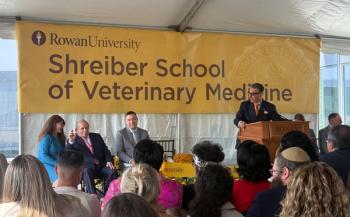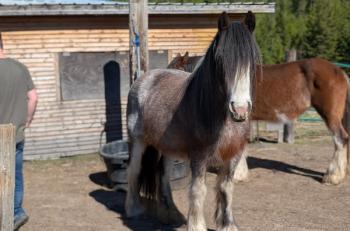
The Lameness Locator: Weird science or industry breakthrough?
Learn how this new technology sees what the human eye cant.
It has been a work in progress. For nearly 20 years, researchers at the College of Veterinary Medicine and the Department of Mechanical and Aerospace Engineering at the University of Missouri and the Hiroshima Institute of Technology have been looking at the gaits of horses and analyzing how these athletes move. Just as important, they have been investigating how veterinarians evaluate their movement.
“I've always been curious why veterinarians sometimes disagree as to if or where a horse is lame,” says Kevin Keegan, DVM, MS, DACVS, a veterinary surgeon and director of the university's equine lameness program. His investigations have progressed from force plate use to high-speed camera analysis of horses on treadmills with instruments attached and include complex mathematical formulas to aid in the description of equine motion.
More recently these researchers have begun using acceleration and gyroscope sensors attached to the horse's body as it's trotted over the ground. The information collected by these sensors is wirelessly sent to a handheld computer that immediately generates gait analysis based on highly technical motion algorithms for evaluation by the clinician. This latest technological development (which is owned by the University of Missouri and licensed to Equinosis for commercial manufacturing and marketing) is available to equine practitioners as the Lameness Locator.
Enhancing the human element
A United States Department of Agriculture equine disease information fact sheet places lameness as the most common medical problem in horses and makes it the most expensive problem as well, if the cost of treatment and loss of use is considered. The American Association of Equine Practitioners provides the current standard for lameness evaluation in a subjective grading scale with discrete levels. “However,” says Keegan, “evidence suggests that subjective evaluation of lameness, even among experts, is only marginally acceptable for lameness of mild severity.”
Most clinicians can agree and accurately locate the lameness in a limping horse with a foot abscess, but the problem cases are horses lame in multiple limbs or those subtly lame with minimal gait abnormalities. Experienced riders or trainers often present their veterinarians with horses that are still competing and not noticeably lame but with the complaint that the horse is “just not right.” Getting the affected limb and location correct in these cases proves to be much more difficult, even for the practitioner with considerable lameness experience. Riders or trainers are commonly told to keep working the horse and bring it back when a visible lameness or more discernable problems develop, which can then be addressed.
Some of this problem is purely physiological, however-even the most advanced or experienced human eye and brain can process only so much information in a short period of time. Typically a human eye can process information 20 to 25 times per second. Experienced people, whether veterinarians looking at lame horses, chess masters looking at a board or your trusted accountant looking at your business ledger, can then package this information into more concise information bundles that allow them to use the data better than the inexperienced human. But they are still limited by physiology.
As a practitioner watches a horse trot, he or she focuses on certain aspects of movement that are learned elements of their lameness detection routine. Many more elements of that horse's movement are unrecorded by the observer, however, simply because he or she cannot process any more information in the short time available. Add to that the fact that certain aspects of movement can be distracting to the observer or may interfere with other more important components of the lameness, and you have an idea of how truly difficult lameness detection in real time can be.
Therefore, says Keegan, development of an objective and more reliable form of lameness evaluation in horses is a worthwhile endeavor. The result of his efforts in this regard is the Lameness Locator, which uses sensors (gyroscopes and accelerometers) to sample more information faster and more times per second than any person can. These sensors sample information 200 times per second, providing a wealth of information usually not available to practitioners.
Keegan is quick to add, however, that the Lameness Locator does not take the practitioner or human element out of lameness diagnosis. “The utility of this equipment really is more parallel to the utility of a microscope or a telescope,” he explains. “It allows you to see things that you otherwise cannot see.” He goes on to explain that lameness in horses is a twofold problem of detection and diagnosis. Detection is a simple measurement process, Keegan says, which can be greatly aided by sensors and computers. Diagnosis and lameness evaluation depend on a much broader knowledge base and background of personal experience, which the seasoned equine clinician has and computers and sensors lack. The combination of the science of the Lameness Locator and the art of equine practice make for a more effective and efficient approach to equine lameness.
Exploring its uses
Jim Waldsmith, DVM, president of Vetel Diagnostics and owner of the Equine Clinic in San Luis Obispo, Calif., both uses and markets the Lameness Locator. In polling existing users of the system, Waldsmith has found that its use falls into three main categories: “Some practitioners only use it for those cases that they cannot block sound or figure out. Others use it on all cases of grade 2 lameness or less where the gait changes can be more subtle or difficult to see. And some veterinarians use it on all cases,” he says. “Most of the comments that I receive are that the Lameness Locator ‘sharpens your eye' or ‘keeps you honest.'”
Numerous studies back up these statements. The lameness locator wireless sensor-based system has been evaluated and found to be highly repeatable. Multiple trials yield similar results, providing the practitioner with a level of confidence in the analysis. It has also been tested and compared to subjective lameness evaluation done by experienced clinicians and shown to be quite reliable. There is good correlation between Lameness Locator results and those achieved by practitioners accomplished in lameness diagnosis. Extensive research projects support the contention that the Lameness Locator method is noninvasive. The instrumentation is simple, rapidly implemented (it takes less than five minutes to apply to the average horse) and well-tolerated. The data analysis is quick and the trials are repeatable with insignificant changes in mean values between successive trials. The final analysis correlates well with experienced subjective evaluation (especially with lameness of grade 2 or worse).
Correlation between the Lameness Locator system and force plate analysis is high for forelimb lameness. Hind limb lameness remains the most difficult type of lameness for clinicians to accurately assess, and correlation between the Lameness Locator and practitioner evaluations of these cases is “statistically significant but not strong.” It's worth noting that correlation on hind limb lameness among even experienced practitioners is poor as well.
Still, a mathematically based lameness evaluation is proving to be advantageous in numerous circumstances. It is most effective in horses with multiple lameness sources. The system can identify the most severe abnormality and allow the clinician to diagnostically block that limb first, which usually leads to a more efficient overall workup. It is beneficial in subtle lameness cases where there is not enough visual information to justify nerve blocks and is surprisingly useful in cases where the horse has no real lameness-the problem may be tack-, rider- or training-related. These cases are often very sensitive, and objective information places the veterinarian in a much stronger position to suggest alternative methods of resolving the problem.
“We find the Lameness Locator's evaluation well-received and useful as a part of an objective follow-up process where we are able to document the efficiency of our treatment-is the lameness becoming ‘less' in a quantifiable way-and to reassess if necessary,” Waldsmith says. The use of a repeatable objective assessment also may potentially help practitioners avoid litigation in such cases as pre-purchase examinations where the clinician traditionally only has his or her subjective evaluation to fall back on if conditions change and problems develop after examination. It may help provide a more complete and objective assessment of an examination done on a particular horse at a particular point in time.
Lameness researchers evaluating treatments or products may find the Lameness Locator beneficial as well, since pretreatment and post-treatment lameness evaluations can be objective and qualitative in a way that has not previously been possible. “There is no doubt that the Lameness Locator will become an integral part of the equine musculoskeletal examination over the next five years,” predicts Waldsmith. “It will likely be driven by new grads seeking a leg up on experienced practitioners or as a means of data collection for pre-purchase examinations and other screening situations. It's also a cost-effective way to monitor a group of performance horses, such as racehorses in training or competition horses, prior to events.” Subtle changes below the clinically observable level can be noted and evaluated with appropriate changes made in training or preemptive treatment performed prior to competition.
But not all equine practitioners have accepted the Lameness Locator. The two most common objections encountered, according to Waldsmith, are price and the opinion by some practitioners that the Lameness Locator cannot improve their lameness detection accuracy.
Keegan also has run into this challenge from older established practitioners, and he equates it to the initial resistance to ultrasound use in reproduction or tendon assessment. Many practitioners had been breeding horses and managing tendon issues relatively successfully for years before the development of this diagnostic modality. There was an initial reaction of “Why do I need a machine to do what I'm already doing?” Over time most veterinarians have come to appreciate that ultrasound merely provides more information that empowers them to make a better diagnostic and treatment plan. Most, if not all, practitioners couldn't imagine going back to a time when ultrasound was not available. Keegan and others hope that the Lameness Locator is considered and eventually accepted in the same way.
“Ultimately clients appreciate that the practitioner cares about the problem, is thinking hard and is employing all available means to get to the heart of the problem,” he says. Perhaps in the not-too-distant future it will also be unconceivable to practice without the aid of advanced lameness diagnostics such as the Lameness Locator.
Dr. Kenneth Marcella is an equine practitioner in Canton, Ga.
Newsletter
From exam room tips to practice management insights, get trusted veterinary news delivered straight to your inbox—subscribe to dvm360.






